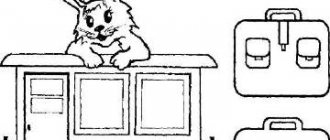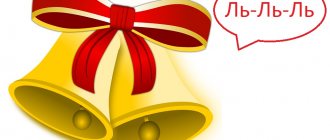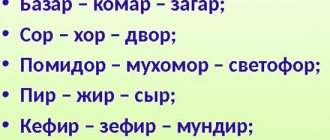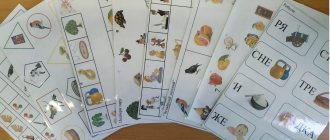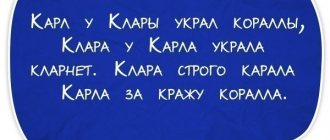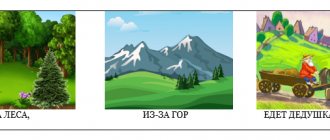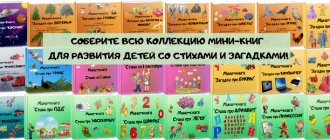Words starting with the syllable "re"
The syllable “RE”, according to the initial sound, belongs to the type - covered
(begins with a consonant), according to the final sound -
open
(ends with a vowel sound), according to the initial and final sound -
open
(is not both closed and closed).
Consisting of 2 syllables:
- recipe
- register
- reflex
- river
- turnip
- belt
- river
- rivers
- river
- river
- rebus
- having decided
- turnips
- registry
- I cut
- rivers
- by the river
- turnip
- river
- rare
- Guys
- cut
- river
- roar
- decided
- you're crying
- rare
- riverman
- rhubarb
- decide
- cuts
- river
- rare
- reverse
- mode
- rivers
- rarely
- decided
- resource
- make up your mind
- reforms
- repair
- rare
- turnip
- will decide
- decide
- turnips
- playfully
- burdock
- rarity
- frisky
- speeches
- frisky
- rare
- radish
- reserve
- decide
- river
- you decide
- refrain
Consisting of 3 syllables:
- restaurant
- editor
- region
- sieve
- Guys
- rivulet
- director
- river
- lattice
- radish
- advertisements
- reflex
- guys
- river
- crafts
- gratings
- radishes
- register
- river
- puzzles
- recipes
- decided
- remark
- rivulets
- registry
- cutting
- crafts
- rivers
- childish
- we decide
- decided
- replica
- rivulet
- registers
- river
- props
- grille
- rare
- decides
- decided
- registers
- slatted
- small river
- craft
- river
- roared
- advertising
- decisions
- made up my mind
- reflexes
- replicas
- sliced
- craft
- recipe
- decided
- reflector
- replica
- frisky
- straps
Consisting of 4 syllables:
- solution
- republic
- guys
- restaurant
- decision
- editor
- region
- registrar
- childishness
- editors
- reflective
- kids
- lattice
- restaurants
- solutions
- receptor
- editor
- for the kids
- handicraft
- restaurant
- receptors
- to the editor
- reflection
- kids
- cutting
- requisites
- restaurants
- decide
- receptors
- editors
- editorial staff
- determination
- audits
- prescription
- republic
- advertising
- editors
- determination
- reflex
- regime
- republics
- regulations
- audit
- advertising
- editorial office
- regions
- republic
- rare
- regions
- repression
- republic
- rare
- speech
- region
- repression
- advertising
- speech
- regions
- decisively
- reforms
Consisting of 5 syllables:
- registration
- restaurants
- registrar
- republican
- registration
- regional
- registry
- reflected
- republican
- complaint
- regional
- republican
- Reshetnikova
- register
- registration
- requisition
- register
- to advertise
- regional
- registration
- republican
- prescription
- editorial
- regional
- reflex
- republican
- editorial
- reflex
- regional
- decisive
- thinning
- reproductive
- repair
- decisive
- reformers
- reproductive
- decisiveness
- restoration
- we are repairing
- decisive
- repertoire
- reformation
- loudspeaker
- restored
- repairs
- decisive
- repertoires
- decisive
- reproduction
- reform
- revolver
- decisive
- rehearse
- rehearsing
- reservation
- revolution
- recombinant
- tutoring
- reserves
- rehearsal
Consisting of 6 syllables:
- registration
- republican
- registration
- regional
- complaint
- registered
- regional
- republican
- advertised
- recording
- advertise
- regional
- revisionist
- registration
- audited
- repaired
- regulate
- restoration
- regulates
- are being repaired
- rehearsed
- revolutionary
- recommendations
- retrospective
- revolutionary
- recommendation
- retrospective
- be regulated
- revolutionary
- recommended
- recommended
- abstract
- traffic controller
- traffic controllers
- adjustable
- recommended
- regulated
- regeneration
- recommended
- respiratory
- regulated
- regulating
- reactive
- regulating
- reactive
- regulating
- reacting
- regulators
- reactionary
- editable
- implementation
- implementation
- implementation
- reclamation
- implemented
- effectiveness
- implemented
- productive
- implemented
- religiosity
Consisting of 7 syllables:
- complaint
- registered
- replication
- registering
- restructuring
- reorganization
- registration
- restructuring
- reorganization
- registration
- restructuring
- reorganization
- reorganized
- registration
- regulated
- regulated
- reforming
- regulating
- resource-supplying
- reduced
- reconnaissance
- reservation
- revolutionary
- recommendatory
- regulation
- revolutionary
- regulation
- revolutionaries
- rehabilitation
- regulation
- revolutionary
- recommendations
- maintainability
- revolutionary
- recommended
- regulatory
- rehabilitation
- recommended
- regulating
- regulating
- reconstructed
- reconstructed
- reconstructed
- editing
- editing
- editing
- recreational
- recreational
- implemented
- implemented
- be realized
- feasibility
- realistic
Consisting of 8 syllables:
- regulation
- regulated
- advertiser
- regulating
- resource-saving
- regulating
- rehabilitation
- rehabilitation
- rehabilitation
- rehabilitated
- rehabilitated
- regenerative
- reconstructed
- reconstructed
Consisting of 9 syllables:
- rehabilitation
- rehabilitation
How to read sheet music
Notes are a kind of alphabet. They indicate the duration and pitch of a sound.
There are only seven notes and they are arranged in the following sequence: do, re, mi, fa, sol, la, si.
How to quickly learn notes?
There is also an international musical alphabet, where notes are written in Latin letters. Explanation of notes:
- C - before;
- D - re;
- E - mi;
- F - fa;
- G - salt;
- A - A;
- H - si.
How to read piano notes? To learn to read music, you also need to become familiar with the musical staff.
The staff consists of five lines and four spaces. The notes are located both on the lines themselves and in the spaces. There are notes in the treble clef and notes in the bass clef.
I use the treble clef to write all notes, starting from the first octave, that is, high. On the staff in the treble clef, from bottom to top, the notes are located on the lines: mi-sol-si-re-fa, and in the intervals: fa-la-do-mi.
The bass clef is the lower register. Just like in the treble clef, the notes of the bass clef on the stave are read from bottom to top, but have a different meaning. Bass clef notes on the lines: sol-si-re-fa-la, in the intervals: la-do-mi-sol.
Both signs should be written at the beginning of the staff on the left.
If we are studying music notation for beginners for the piano, then we need to remember that the keys are often combined into a system when writing notes for the instrument.
You can also come across the signs - sharp and flat.
A sharp is an increase by a semitone. So, for example, if you need to raise the note “E” by a semitone, then you need to write E sharp, and if you lower it, then write E flat.
Flat - lowers the sound by a semitone.
Bekar is a sign that cancels sharp and flat.
Flats and sharps are written on lines or in spaces, but correspond to those notes that are on the corresponding lines or spaces.
Easy notes for piano
There is another important concept in music - harmony. This is a system of stable and unstable sounds, united by a tonic.
There are two common patterns:
Major is a mode whose sustained sounds form a major triad. It is built like this: tone-tone-semitone-tone-tone-tone-semitone.
The minor scale is built in the following order: tone-semitone-tone-tone-semitone-tone-tone.
When denoting tonality, the name of the mode is added to the name of the tonic: D major, E minor.
The white and black keys on the piano are notes.
Popular Pieces to Play on the Piano for Beginners
"Song of Captain Vrungel"
The song from the 1981 cartoon “The Adventures of Captain Vrungel” has become a cult classic. Music written by Georgy Fitch, lyrics by E. Cherepovetsky. The song is performed dynamically, but this will not prevent young musicians from quickly mastering it.
"Antoshka"
A cheerful and playful song about Antoshka, written by Shainsky with lyrics by Yuri Entin, is well suited for beginning pianists to practice the technique of transitioning from the treble clef to the bass clef.
"Song of the Hare and the Wolf at the Carnival"
The well-known song “Tell me, Snow Maiden, where you were...” from “Well, wait a minute!” Quite easy to perform. In addition, it is written in one of the simplest keys, D major, so it is easy to play, and the well-known motive helps you remember the notes.
"A true friend"
Timka and Dimka are true friends, whose friendship cannot be watered down. The entire song is built on several repeating chords that sound like shimmers. Therefore, notes are quickly memorized even for children.
"If only it weren't winter"
This song, although in no way inferior in its popularity to the previous ones, is an order of magnitude more difficult to perform. A simple and familiar motif from childhood based on Entin’s words hides three staves on which two treble clefs and a bass clef are located.
"Three piglets"
The melody written by Frank Churchill should be performed cheerfully and cheerfully. A very common technique used is Staccato, which means that the fingers should bounce off the piano keys. Good practice for beginners to practice this technique.
Music from the film "Amelie"
The movie "Amelie" is largely remembered thanks to the wonderful melody of Yann Tiersen. The melody is performed quietly and moderately, while the composer used beautiful combinations of chords that are easy to learn.
Volume
The volume level of music is its dynamic tone.
When playing one piece of music or even a small fragment, several dynamic shades can be used at once.
There is a constant volume:
- Fortissimo (ff) - the highest volume;
- forte (f) - loudly;
- mezzo forte (mf) - medium volume;
- mezzo piano (mp) - low volume;
- piano (p) - quiet;
- pianissimo (pp) - quietly.
How loud a piece is played often depends on its tempo. The march will sound loud and fast, and the romance will sound slow and muffled.

